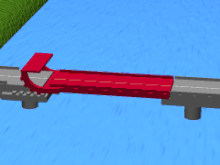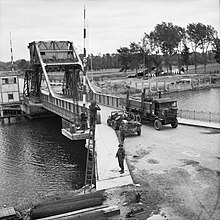Pegasus Bridge
The Pegasus Bridge (until 1944 Bénouville Bridge ) at Bénouville in France is a first time in 1935 built Wippbrücke type Scherzer over the Caen canal . With this special type of bridge, the bridge is not folded up around a pivot point, but the entire construction is rolled out on a segment of a circle and the pivot point is shifted horizontally.
On D-Day it was captured by Allied airborne units of the British 6th Airborne Division under the command of Major John Howard during Operation Tonga . As a result, it was officially named "Pegasus Bridge" after a winged horse on the shoulder of the unit. The current bridge is slightly larger than the old one and dates from 1994.
The fight for the bridge
The main objective of conquering the bridge was to secure the eastern flank of the invading forces in Normandy. It should be prevented that the troops would be "rolled up" sideways by a counterattack. The eastern flank was the Orne River and the Caen Canal. The only crossings over these watercourses were the Pegasus Bridge and the Horsa Bridge, which were later named so . Conquering these bridges would secure the entire flank.
The first attack was carried out by 181 soldiers of the 2nd Oxfordshire and Buckinghamshire Light Infantry Regiment under the command of Major John Howard. The operation is sometimes incorrectly referred to as "Operation Coup de Main", but historically it has no name of its own. This is also made clear by the fact that the original orders that Major Howard received from Brigadier Nigel Poett do not contain any designation.
On June 6, 1944, at 12:16 a.m., three gliders landed close together, 50 meters from the Pegasus Bridge. The first glider No. 92 carried Major Howard and the 1st train. A hard landing was planned so that the aircraft nose would remove the first barbed wire entanglements in front of the bridge. This type of landing threw the two pilots of the glider through the Plexiglas cladding of the cockpit outside.
The soldiers quickly realized that despite the hard landing no one had noticed anything and that outside everything remained quiet, although the German guards on the bridge were only 50 meters away. It was later revealed that the guards had mistaken the glider's landing for falling debris from a downed Allied bomber. The 1st platoon quickly freed itself from the glider and was just as quickly able to disable a machine gun position on the bridge. The rest of the platoon, under Lieutenant Brotheridge, crossed the bridge firing and throwing hand grenades. Another machine gun emplacement was captured on the other bank, with Lieutenant Brotheridge being fatally wounded. He was the first victim of the invasion on the Allied side.
The 2nd platoon landed shortly after the start of the attack and assisted the 1st platoon in crossing the bridge. The landing of the 3rd train did not go as smoothly as some of the men were trapped in the wreck of the sailor during the hard landing, one was thrown into a nearby lake. After they freed themselves, they also supported the attack on the west end of the bridge.
During the attack, pioneers of the 249th Field Company climbed the bridge and examined it for explosives. They discovered that although the bridge was prepared for demolition and all the wires were in place, the explosives were not yet on site for fear of accidents or sabotage by the French Resistance . The German bridge watch was completely taken by surprise and was only gradually able to decide to launch a counterattack. But when they realized that resistance was futile, many soldiers fled. The Bénouville or Pegasus Bridge was thus under British control.
The Ranville or Horsa Bridge spanned the Orne 600 meters to the east . This was the second destination of the British and was approached by three other cargo sailors. One of the gliders missed the landing zone and landed several kilometers from the bridge, so that its soldiers could not intervene in the fighting.
The other two gliders landed nearby. The 6th platoon landed first and began attacking the bridge. The German security team was now alarmed by the noise of the battle from the Pegasus Bridge. The Germans' ability to defend themselves, however, was limited to a single machine gun emplacement. The crew fired some untargeted volleys at the advancing British, but then fled when their position was taken under mortar fire. The bridge could be captured without further resistance.
The 5th platoon landed a few minutes later 700 meters from the bridge and reached it when the fighting on the bridge had already ended. This mission was a complete success for the British troops.
Both bridges were conquered within ten minutes with comparatively low losses. The landing of the gliders in the very narrow landing zones was later recognized by the commander-in-chief of the Allied air forces during the invasion, Deputy Air Marshal Leigh-Mallory, as "one of the most outstanding maneuvers of the war".
Forty minutes after the bridge was captured, parts of the British 6th Airborne Division parachuted to aid the bridge's defenders. These had to defend themselves against sparse counterattacks by German troops for two hours until reinforcements arrived.
The role of the 7th Parachute Battalion, which jumped west of the Caen Canal and thus had to intercept the main force of the German counterattacks on the bridges on June 6, is often overlooked in the attack on the bridges. 600 men jumped off, but they landed widely scattered due to adverse jumping conditions. Only about 300 soldiers showed up at the assembly point. All equipment such as machine guns and mortars had been lost. Nevertheless, they built a bridgehead around the Pegasus Bridge and fended off constant enemy counter-attacks, although these were also supported by armored vehicles. In the place Bénouville individual units were partially surrounded by German armed forces.
The first reinforcements to appear on the scene were the 6th Commandos, led by Lord Lovat , who marched towards the bridges to the sound of bagpipes. These reinforcements were not actually intended for the occupiers of the bridge or the 7th battalion, but it was the task of the 6th commandos to march across the bridge and secure the area east of the Caen Canal, which was still used by units of the German 716th Infantry Division was held. The 7th Battalion had to hold out with great losses until 9:15 p.m. until the Royal Warwickshire Regiment had found its way from the invasion beaches to the bridges and liberated Bénouville.
Post-war period and new building
The street over the Pegasus Bridge was renamed Major Howard Avenue in John Howard's honor. After the Second World War, the movement of goods on the Caen Canal increased sharply and the ships got bigger and bigger. This required the expansion of the canal and ultimately the replacement of the bridge. In order to preserve the historical overall impression, an enlarged copy of the Pegasus Bridge was built. This new bridge was inaugurated in 1994 on the 50th anniversary of the invasion. The bridge is 42.20 meters long, 9.70 meters wide and 11 meters high. The old bridge can be seen in the outer area of the airborne museum "Pegasus Bridge", which is 150 m east of the bridge .
Use in media
The battle for the Pegasus Bridge became one of the most famous events of the Allied invasion of Normandy. Many films, books and other media processed the battle for the Pegasus Bridge.
The 1962 feature film " The Longest Day " recreates the conquest of the Pegasus Bridge under the command of Major John Howard (played by Richard Todd ). The film is based on the non-fiction book of the same name by Cornelius Ryan . The film also shows other parts of the Allied landing in Normandy.
In the computer games Call of Duty , The Perfect General and Battlefield 1942 you can re-enact the attack on the Pegasus Bridge in a separate mission.
See also
- Café Gondrée - Café next to the bridge
Web links
- Pegasus Bridge. In: Structurae
- More information about the Pegasus Bridge
- Website of the Airborne Museum "Pegasus Bridge" (French)
- Information on the storming of the Pegasus Bridge (English)
- Photo material u. a. to the Pegasus Bridge (English)
- History of the Pegasus Bridge ( Memento from March 20, 2008 in the Internet Archive )
- Pegasus Memorial (English)
- BBC "The People's War" (English)
- The bridge in 1944 (English)
- Detailed description of the environment (English)
Coordinates: 49 ° 14 ′ 32.4 " N , 0 ° 16 ′ 27.7" W.





